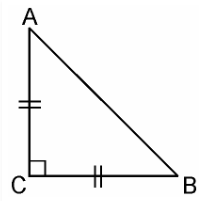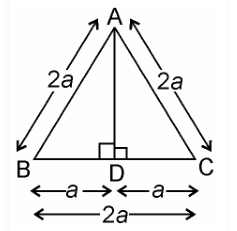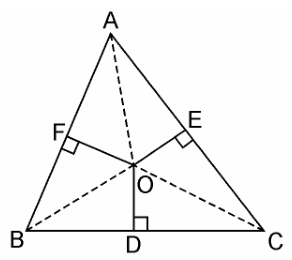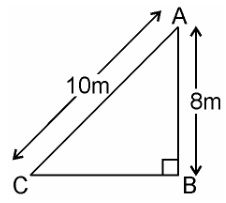Sides of triangles are given below. Determine which of them are right triangles. In case of a right triangle, write the length of its hypotenuse.
(i) 7 cm, 24 cm, 25 cm
(ii) 3 cm, 8 cm, 6 cm
(iii) 50 cm, 80 cm, 100 cm
(iv) 13 cm, 12 cm, 5 cm
(i) 7 cm, 24 cm, 25 cm
Given, sides of the triangle are 7 cm, 24 cm, and 25 cm
Squaring the lengths of the sides of the, we will get 49, 576, and 625
49 + 576 = 625
$(7)^2 + (24)^2 = (25)^2$
Therefore, the above equation satisfies, Pythagoras theorem. Hence, it is right angled triangle
Length of Hypotenuse = 25 cm
(ii) 3 cm, 8 cm, 6 cm
Given, sides of the triangle are 3 cm, 8 cm, and 6 cm
Squaring the lengths of these sides, we will get 9, 64, and 36
Clearly, 9 + 36 ≠ 64
Or, $3^2 + 6^2 ≠ 8^2$
Therefore, the sum of the squares of the lengths of two sides is not equal to the square of the length of the hypotenuse
Hence, the given triangle does not satisfies Pythagoras theorem
(iii) 50 cm, 80 cm, 100 cm
Given, sides of triangle’s are 50 cm, 80 cm, and 100 cm
Squaring the lengths of these sides, we will get 2500, 6400, and 10000
However, 2500 + 6400 ≠ 10000
Or, $50^2 + 80^2 ≠ 100^2$
As you can see, the sum of the squares of the lengths of two sides is not equal to the square of the length of the third side
Therefore, the given triangle does not satisfies Pythagoras theorem
Hence, it is not a right triangle
(iv) 13 cm, 12 cm, 5 cm
Given, sides are 13 cm, 12 cm, and 5 cm
Squaring the lengths of these sides, we will get 169, 144, and 25
Thus, 144 +25 = 169
Or, $12^2 + 5^2 = 13^2$
The sides of the given triangle are satisfying Pythagoras theorem
Therefore, it is a right triangle
Hence, length of the hypotenuse of this triangle is 13 cm
Given, ΔPQR is right angled at P is a point on QR such that PM $\perp$ QR

We have to prove, $PM^2$ = QM × MR
In ΔPQM, by Pythagoras theorem
$PQ^2 = PM^2 + QM^2$
Or, $PM^2 = PQ^2 – QM^2$ ……………………………..(i)
In ΔPMR, by Pythagoras theorem
$PR^2 = PM^2 + MR^2$
Or, $PM^2 = PR^2 – MR^2$ ………………………………………..(ii)
Adding equation, (i) and (ii), we get
$2PM^2 = (PQ^2 + PM^2) – (QM^2 + MR^2)$
= $QR^2 – QM^2 – MR^2 [∴ QR^2 = PQ^2 + PR^2]$
= $(QM + MR)^2 – QM^2 – MR^2$
= 2QM × MR
$PM^2$ = QM × MR
In Fig. 6.53, ABD is a triangle right angled at A and AC $\perp$ BD. Show that
(i) $AB^2$ = BC . BD
(ii) $AC^2$ = BC . DC
(iii) $AD^2$ = BD . CD

(i) $AB^2$ = BC . BD
In ΔADB and ΔCAB
$\angle DAB = \angle ACB $(Each 90°)
$\angle ABD = \angle CBA $(Common angles)
ΔADB ~ ΔCAB [AA similarity criterion]
$\dfrac{AB}{CB} = \dfrac{BD}{AB}$
$AB^2$ = CB × BD
(ii) $AC^2$ = BC . DC
Let $\angle CAB$ = x
In ΔCBA
$\angle CBA$ = 180° – 90° – x
$\angle CBA$ = 90° – x
Similarly, in ΔCAD
$\angle CAD = 90° – \angle CBA$
= 90° – x
$\angle CDA$ = 180° – 90° – (90° – x)
$\angle CDA$ = x
In ΔCBA and ΔCAD, we have
$\angle CBA = \angle CAD$
$\angle CAB = \angle CDA$
$\angle ACB = \angle DCA$ (Each 90°)
ΔCBA ~ ΔCAD [AAA similarity criterion]
$\dfrac{AC}{DC} = \dfrac{BC}{AC}$
$AC^2$ = DC × BC
(iii) $AD^2$ = BD . CD
In ΔDCA and ΔDAB
$\angle DCA = \angle DAB$ (Each 90°)
$\angle CDA = \angle ADB$ (common angles)
ΔDCA ~ ΔDAB [AA similarity criterion]
$\dfrac{DC}{DA} = \dfrac{DA}{DA}$
$AD^2$ = BD × CD
Given, ΔABC is an isosceles triangle right angled at C

In ΔACB, $\angle C$ = 90°
AC = BC (By isosceles triangle property)
$AB^2 = AC^2 + BC^2$ [By Pythagoras theorem]
= $AC^2 + AC^2$ [Since, AC = BC]
$AB^2 = 2AC^2$
Given, ΔABC is an isosceles triangle having AC = BC and $AB^2 = 2AC^2$

In ΔACB
AC = BC
$AB^2 = 2AC^2$
$AB^2 = AC^2 + AC^2$
= $AC^2 + BC^2$ [Since, AC = BC]
Hence, by Pythagoras theorem ΔABC is right angle triangle
Given, ABC is an equilateral triangle of side 2a

Draw, AD $\perp$ BC
In ΔADB and ΔADC
AB = AC
AD = AD
$\angle ADB = \angle ADC$ [Both are 90°]
Therefore, ΔADB ≅ ΔADC by RHS congruence
Hence, BD = DC [by CPCT]
In right angled ΔADB
$AB^2 = AD^2 + BD^2$
$(2a)^2 = AD^2 + a^2 $
$AD^2 = 4a^2 – a^2$
$AD^2 = 3a^2$
AD = $\sqrt{3a}$
Given, ABCD is a rhombus whose diagonals AC and BD intersect at O.

We have to prove, as per the question,
$AB^2 + BC^2 + CD^2 + AD^2 = AC^2 + BD^2$
Since, the diagonals of a rhombus bisect each other at right angles.
Therefore, AO = CO and BO = DO
In ΔAOB,
$\angle AOB$ = 90°
$AB^2 = AO^2 + BO^2$ …………………….. (i) [By Pythagoras theorem]
Similarly,
$AD^2 = AO^2 + DO^2$ …………………….. (ii)
$DC^2 = DO^2 + CO^2$ …………………….. (iii)
$BC^2 = CO^2 + BO2$ …………………….. (iv)
Adding equations (i) + (ii) + (iii) + (iv), we get,
$AB^2 + AD^2 + DC^2 + BC^2 = 2(AO^2 + BO^2 + DO^2 + CO^2)$
= $4AO^2 + 4BO^2$ [Since, AO = CO and BO =DO]
= $(2AO)^2 + (2BO)^2 = AC^2 + BD^2$
$AB^2 + AD^2 + DC^2 + BC^2 = AC^2 + BD^2$
Hence, proved.
In Fig. 6.54, O is a point in the interior of a triangle ABC, OD $\perp$ BC, OE $\perp$ AC and OF $\perp$ AB. Show that
(i) $OA^2 + OB^2 + OC^2 – OD^2 – OE^2 – OF^2 = AF^2 + BD^2 + CE^2$
(ii) $AF^2 + BD^2 + CE^2 = AE^2 + CD^2 + BF^2$

Given, in ΔABC, O is a point in the interior of a triangle
And OD $\perp$ BC, OE $\perp$ AC and OF $\perp$ AB
Join OA, OB and OC

(i) $OA^2 + OB^2 + OC^2 – OD^2 – OE^2 – OF^2 = AF^2 + BD^2 + CE^2$
By Pythagoras theorem in ΔAOF, we have
$OA^2 = OF^2 + AF^2$
Similarly, in ΔBOD
$OB^2 = OD^2 + BD^2$
Similarly, in ΔCOE
$OC^2 = OE^2 + EC^2$
Adding these equations,
$OA^2 + OB^2 + OC^2 = OF^2 + AF^2 + OD^2 + BD^2 + OE^2 + EC^2$
$OA^2 + OB^2 + OC^2 – OD^2 – OE^2 – OF^2 = AF^2 + BD^2 + CE^2$
(ii) $AF^2 + BD^2 + EC^2 = (OA^2 – OE^2) + (OC^2 – OD^2) + (OB^2 – OF^2)$
$ AF^2 + BD^2 + CE^2 = AE^2 + CD^2 + BF^2$
Given, a ladder 10 m long reaches a window 8 m above the ground.

Let BA be the wall and AC be the ladder,
Therefore, by Pythagoras theorem,
$AC^2 = AB^2 + BC^2$
$10^2 = 8^2 + BC^2$
$BC^2$ = 100 – 64
$BC^2$ = 36
BC = 6m
Therefore, the distance of the foot of the ladder from the base of the wall is 6 m.
Given, a guy wire attached to a vertical pole of height 18 m is 24 m long and has a stake attached to the other end

Let AB be the pole and AC be the wire
By Pythagoras theorem,
$AC^2 = AB^2 + BC^2$
$24^2 = 18^2 + BC^2$
$BC^2$ = 576 – 324
$BC^2$ = 252
BC = $6\sqrt{7}m$
Therefore, the distance from the base is $6\sqrt{7}$m
